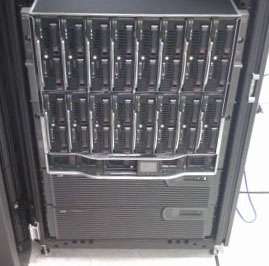HPE BladeSystem
BladeSystem is a line of blade server machines from Hewlett Packard Enterprise (Hewlett-Packard before 2015) that was introduced in June 2006.[1][2][3]

The BladeSystem forms part of the HPE Converged Systems platform, which use a common converged infrastructure architecture for server, storage, and networking products.[4] Designed for enterprise installations of 100 to more than 1,000 Virtual machines, the HP ConvergedSystem 700 is configured with BladeSystem servers.[5] When managing a software-defined data center, a System administrator can perform automated lifecycle management for BladeSystems using HPE OneView for converged infrastructure management.[6]
The BladeSystem allows users to build a high density system, up to 128 servers in each rack.[7]
Components
Enclosures

As of November 2019, HPE offers 2 types of enclosures in its BladeSystem lineup.
c7000
The BladeSystem c7000 enclosure has had multiple versions, the first version of which was announced in June 2006. In 2007 there was a minor update to the first version that included a larger Onboard Administrator display (3 inches, up from 2 inches). The next update (second version) was in 2009 and brought RoHS compatibility, increased backplane speed (5Tbit/s, up from 4Tbit/s), 1Gbit/s Onboard Administrator connectivity, and increased blade connectivity options like: 2x 10Gbit/s Ethernet support, 4x QDR or 1x FDR InfiniBand port support, and 6Gbit/s SAS. The third version of the c7000 enclosure, called the c7000 Platinum Enclosure was released in February 2013. It features location discovery services, thermal discovery services and redesigned backplane. The new backplane increased aggregate bandwidth 40% from 5 to 7 Tbit/s to allow use newest high-speed interconnect modules (such as 16Gbit/s FC and multiple ports of 56Gbit/s FDR InfiniBand). Also the new Platinum Plus rating power supplies were announced with higher efficiency than previous Gold Plus rating power supplies.[8]
All versions of the enclosure occupy 10 rack units and can accommodate up to 16 half-height blade servers. It includes space for 6 power supplies (single-phase, three-phase or a −48V DC), 10 cooling fans, 8 single-wide (such as 1/10Gbit/s Ethernet or 8/16Gbit/s FC) or 4 double-wide (such as 40Gbit/s Ethernet or Infiniband) interconnect modules (that allows for up to 4 redundant interconnect fabrics)
c3000
The HPE c3000 enclosure was announced in August 2007. Updated version of the enclosure called c3000 Platinum was announced in February 2013.
All versions of the enclosure occupy 6 rack units or can be used as a standalone unit (with optional tower conversion kit) It can accommodate up to 8 half-height blade servers. It includes space for 6 power supplies (single-phase, or a -48V DC), 6 cooling fans, 4 single-wide or 2 single-wide and one double-wide interconnect modules
Server blades

HPE has offered general-purpose Proliant server blades (based on Intel Xeon and AMD Opteron CPUs) as well as Integrity (based on the Intel Itanium CPU) and specialized Proliant blades aimed at workstation virtualization. Blades can use half-height/full-height and single-wide/double-wide/quad-wide form factors. Apart from built-in 1Gbit/s Ethernet network adapters, optional mezzanine cards can be installed on the blades to further increase connectivity options.
In the latest generation (Gen10 - Released: July 2017), HPE offers half-height Proliant BL460c blade servers[9] with up to 2 Intel Xeon Scalable - 2nd Generation CPUs, 2TB of DDR4 Memory, and 2x PCIe 3.0 x16 I/O expansion mezzanine slots.
Networking
Several connectivity options are available for the HPE BladeSystem:
Storage
Storage options include:
- Internal server HDDs (usually 2 to 4 with hot-swap capabilities)
- Internal USB, SD or microSD slot
- Connecting to external SAN via FC, SAS or iSCSI; enabled by the use of a mezzanine I/O card
- Storage blade (with large number of internal HDD's)
- Tape blade (half-height blade unit hosting LTO tape drive and designed to connect to adjacent blade server)
References
- https://www.hpe.com/info/bladesystem
- "Archived copy". Archived from the original on 2012-01-21. Retrieved 2011-01-06.CS1 maint: archived copy as title (link)
- https://archive.is/20120717211616/http://whitepapers.techrepublic.com.com/abstract.aspx?docid=1930905
- Rouse, Margaret. (2013–12). “Definition: Converged Infrastructure,” TechTarget.com.
- Morgan, Timothy Prickett. (2013-4-29). “HP mashes up ProLiant, Integrity, BladeSystem, and Moonshot server business,” The Register.com.
- Tiano, Luigi. (2013-9-28). “HP OneView Managing the Converged Infrastructure Data Center,” 1CloudRoad.
- "HP Puts 1000 Cores in a Single Rack". Tom's Hardware. June 11, 2008. Retrieved 14 Apr 2013.
- "HP cranks up bandwidth on BladeSystem sheaths, adds pretty platinum stripe".
- HPE BL460c Gen10 QuickSpecs